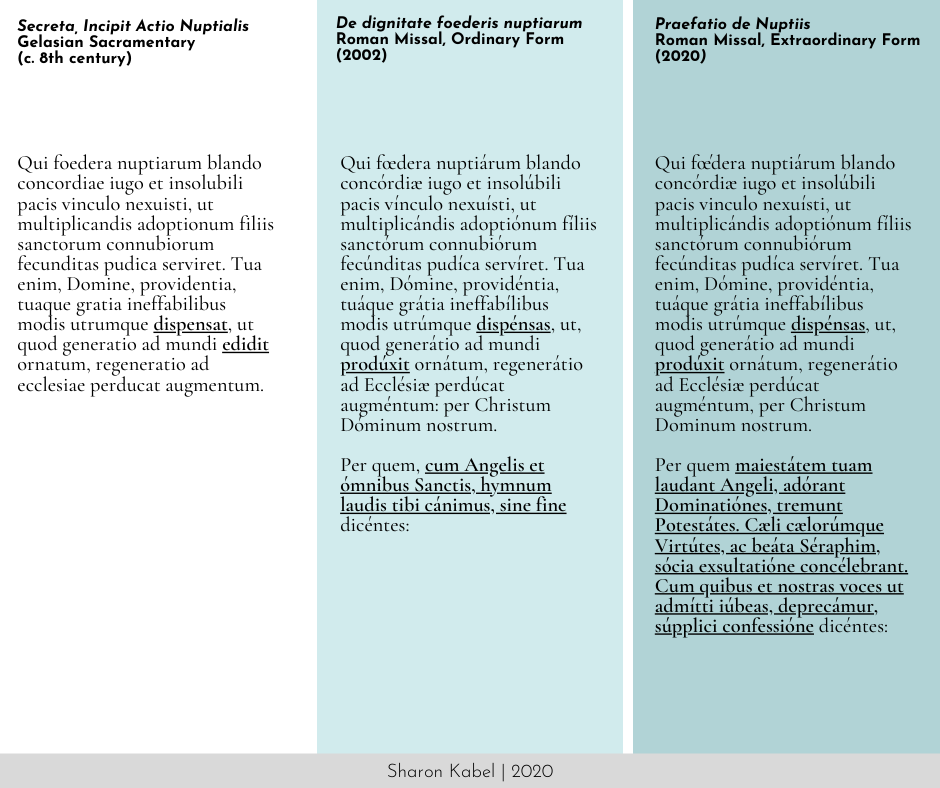A New-Old Preface for Latin Mass Weddings
On March 25, 2020, the Congregation for the Doctrine of Faith announced that they had approved seven new prefaces for optional use in the Extraordinary Form, or the Traditional Latin Mass.
One of the “new” prefaces, Praefatio de Nuptiis is for the wedding Mass, the Missa pro sponso et sponsa. From the Vatican’s announcement:
“Finally, special note should be taken of the Preface de Nuptiis, which together with the long Nuptial Blessing still in use in Masses pro Sponsis, is to be found – with minor variations – in early Sacramentaries such as the Gelasianum Vetus or the Gregorianum. This ancient Preface, already existing in the forma ordinaria, may therefore now be used in the forma extraordinaria as well.”
The full text of the prefaces were released today, March 26.
What’s a preface?
The preface is a part of the Order of the Mass. It takes places before the Sanctus.
“The preface (it will be different during Lent, Paschaltide, Ascension, and for Feasts that have their own Preface) is a prayer of thanksgiving and total praise. It leads right into the Sanctus (the “Trisagion” or “Tersanctus,” meaning “Thrice Holy”) – the words of Psalm 117 and Matthew 21:9 blended with the words of the Angels of Isaias 6:3 and Apocalypse 4 who sing “holy, holy, holy” day and night without ceasing and who sing with us now.” Fisheaters: Order of the Mass
Do I need to use it for my Latin Mass wedding?
No, all seven of these recently released prefaces are optional!
That said, the Praefatio de Nuptiis is actually almost identical to one of three preface options in the Novus Ordo, so it will be familiar to priests who might otherwise be unfamiliar with Latin Mass texts.
So what’s the new preface?
PRÆFATIO DE NUPTIIS
Præfatio de Nuptiis dici potest in Missis votivis “Pro Sponsis”.
V/. Per ómnia sǽcula sæculórum. R/. Amen.
V/. Dóminus vobíscum. R/. Et cum spíritu tuo.
V/. Sursum corda. R/. Habémus ad Dóminum.
V/. Grátias agámus Dómino Deo nostro.
R/. Dignum et iustum est.
Vere dignum et iustum est, æquum et salutáre, nos tibi semper et ubíque grátias ágere: Dómine, sancte Pater, omnípotens ætérne Deus: Qui fœ́dera nuptiárum blando concórdiæ iugo et insolúbili pacis vinculo nexuísti, ut multiplicándis adoptiónum fíliis sanctórum connubiórum fecúnditas pudíca servíret. Tua enim, Dómine, providéntia, tuáque grátia ineffabílibus modis utrúmque dispénsas, ut, quod generátio ad mundi prodúxit ornátum, regenerátio ad Ecclésiæ perdúcat augméntum, per Christum Dominum nostrum. Per quem maiestátem tuam laudant Angeli, adórant Dominatiónes, tremunt Potestátes. Cæli cælorúmque Virtútes, ac beáta Séraphim, sócia exsultatióne concélebrant. Cum quibus et nostras voces ut admítti iúbeas, deprecámur, súpplici confessióne dicéntes:
Sanctus, Sanctus, Sanctus Dóminus Deus Sábaoth. Pleni sunt cæli et terra glória tua. Hosánna in excélsis. Benedíctus qui venit in nómine Dómini. Hosánna in excélsis.
Where did this preface come from?
The text for this preface is taken almost exactly from the Gelasian Sacramentary, and as mentioned earlier, already exists as one of three options in the Novus Ordo. The image below for this post is a side-by-side comparison of the Gelasian prayer, the Novus Ordo preface, and the “new” Latin Mass preface. I’ve bolded and underlined the differences.

Is there an English version?
Not yet! However, as the Praefatio de Nuptiis is almost identical to one of the Novus Ordo nuptial prefaces, we can borrow the translation of the Novus Ordo prefaces for a preview.
A: The dignity of the marriage covenant
Roman Missal, Ordinary Form (2002)
It is truly right and just, our duty and our salvation, always and everywhere to give you thanks, Lord, holy Father, almighty and eternal God. For you have forged the covenant of marriage as a sweet yoke of harmony and an unbreakable bond of peace, so that the chaste and fruitful love of holy Matrimony may serve to increase the children you adopt as your own. By your providence and grace, O Lord, you accomplish the wonder of this twofold design: that, while the birth of children brings beauty to the world, their rebirth in Baptism gives increase to the Church, through Christ our Lord.